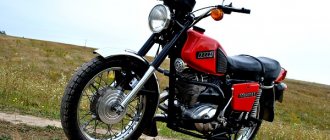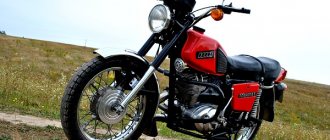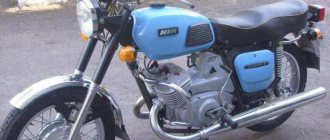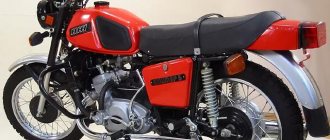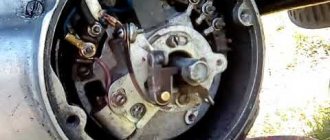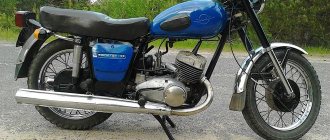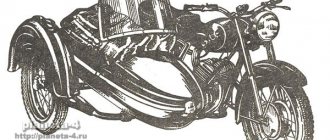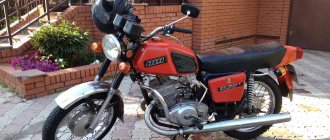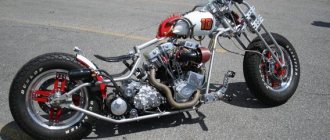In 1980, the Izhevsk Machine-Building Plant launched the IZH Jupiter 4 road motorcycle for mass production. The fourth generation replaced its predecessor IZH Jupiter 3 on the production line and was produced until 1986.
Jupiter 4 could confidently move on roads with any surface, and its key feature was the ability to be used together with a passenger side trailer, which made it possible to transport two passengers at once or use the trailer to transport small loads.
It is the increased passenger capacity that has become an important component of the popularity of motorcycles. In addition, it had the following advantages:
- good dynamic characteristics;
- ease of repair;
- high cross-country ability;
- affordable price;
- high reliability;
- low sensitivity to fuel quality.
The existing disadvantages of IZH Jupiter 4, according to reviews from owners, include:
- poor assembly quality at the factory (connections not tightened, poor contacts, oil leaks);
- violation of synchronization in the operation of the engine cylinders;
- poor wiring diagram;
- frequent overheating of the engine when fully loaded in warm weather.
But due to the corresponding advantages, the motorcycle was most popular among rural residents as a universal vehicle.
Basic data of IZH Jupiter 4K in millimeters - mm.
Wheelbase (distance between wheel axles), - 1450 Ground clearance at full load and normal tire pressure, - 125 Overall dimensions: length - 2200 width - 1700 height - 1800 Weight (dry), kg. — 255 Maximum load, kg. — 265 Load on side trailer, kg. — 115 Maximum speed, km/h. — 95 Braking distance at a speed of 60 km/h, in meters. — 25 Control fuel consumption per 100 km in liters — 7.5
Back to contents — ↑
About the disadvantages
It is worth noting that among owners of IZH motorcycles, the Jupiter IZH-4 model is not very popular. Experienced users claim that the fourth “Jupiter” is the most unsuccessful model from the entire range of IZH motorcycles. In addition to the fact that the strength of the high-speed engine leaves much to be desired, Jupiter-4 has the following “diseases” and disadvantages:
- constant oil leakage from the engine crankcase;
- “ringing” of fingers after short use;
- short gearbox resource;
- constant problems with the ignition system;
- high fuel consumption;
- lack of monitoring systems for fuel level, engine temperature and oil level in the crankcase;
- out-of-date design;
- Lack of knowledge in the field of operation and repair of this motorcycle can lead to significant material costs for repairing the unit and/or treating the biker.
Most owners of Soviet motorcycles are confident in the above. Particular attention must be paid to the ignition system. In fact, the process of setting the ignition timing does not require phenomenal skills or special knowledge.
Engine IZH Jupiter 4K technical specifications
Engine type - Two-stroke, two-cylinder Cylinder diameter, mm - 62 Piston stroke, mm - 57.6 Compression ratio - 9.95 Displacement, cm³ - 347.6 Maximum engine power (at 5600-6200 rpm), l. With. — 28 Lubrication system — together with fuel Ignition system — battery Carburetor — K-62D Fuel used — gasoline with an octane number of at least 76 Air cleaner — contact oil Cooling — counter-flow air
Back to contents — ↑
Reviews
Reviews of “Jupiter IZH-4” have both positive and negative. Some of the bike owners are confident that if you treat your equipment with care and carry out technical inspections and repairs in a timely manner, the results will not take long to arrive. When purchasing a motorcycle, you can have virtually zero knowledge regarding repair and operation. The main thing is that the Jupiter IZH-4 was purchased either in good condition or was completely renovated. Then many problems and “diseases” of the motorcycle will not bother the driver.
Other owners of this motorcycle consider high engine power and excellent acceleration performance to be positive aspects. If you make a few changes to the design, IZH Jupiter-4 can easily take on a modern, attractive look.
Complaints mainly concern unstable voltage regulator relays, problems with the ignition system and rapid wear of engine elements.
Power transmission IZH Jupiter 4K technical specifications
The transmission from the engine to the clutch is a double-row motor chain. The clutch is multi-plate in an oil bath. The gearbox is four-speed. Gear shifting is by foot lever, with automatic manual clutch release. Transmission to the rear wheel is a single-row chain, protected from dirt, sand and moisture. Gear ratio from the engine to the clutch - 2.57 Gear ratio to the rear wheel - 2.63 Gearbox ratio: At first speed - 3.17 At second speed - 1.81 At third speed - 1.26 At fourth speed – 1.0 Overall gear ratio: In first gear – 21.35 In second – 12.24 In third – 8.48 In fourth – 6.74
Back to contents — ↑
How did the motorcycle turn out the way it is?
The metal is sanded and coated with clear acrylic varnish. Selected color combinations and everything glossy are still boring from fiddling with computer programs. I wanted something like the so-called post-apocalyptic industrial theme. Here, for example, from the Detroit Bros workshop:
In general, I decided to assemble the Jupiter without the side borders and so that it would all shine with the steel from which it is made.
I bought a kilogram package of car varnish, it turned out to be acrylic, from Vika (about 500 rubles). I also bought thinner for acrylic paints and varnishes, also from Vika (a couple of jars for 90 rubles each), but later the hardener ran out faster than the thinner (a small jar of hardener was included with a jar of varnish). It seems that the domestic solvent R-12 is friendly with any acrylic paints and varnishes, but I have not checked.
I planned to paint with a purchased touch-up airbrush from MATRIX - with a simple round nozzle, a 0.2-liter aluminum tank, designed specifically for regular paint (not for all sorts of filling primers, which require a large diameter nozzle, greater pressure and, accordingly, greater air flow), produces spot from 5 mm to 4-5 centimeters, economically consumes paint.
I bought this touch-up airbrush for 690 rubles. And for 200 rubles a filter drier is small for him, for another 50 rubles for a set of two flanges (for a thin oxygen hose) and two nuts for a bayonet connection of such a flange to the airbrush.
On occasion, I got the compressor quite inexpensively, homemade, from a compressor from a refrigerator, a small receiver, a pressure gauge on the receiver itself, and an oxygen reducer with a thin oxygen hose. I've already modified it a little:
And also modified:
Steampunk compressor:
Such a compressor will not handle spray guns with high air consumption, but my touch-up airbrush works, and a small airbrush will work even more so. Although you can try a small spray gun with an LVLP spray system (originally made to work at low pressure and air flow) from IWATA, for example (I saw it on the Internet for 2300 rubles). But the compressor works no louder than a refrigerator. Otherwise, I would buy a compressor from my next salary (this is approximately 5,000 - 7,000 rubles).
Electrical equipment IZH Jupiter 4K technical specifications
Battery – 12 volts, 6MTS-9. Alternating current generator – 12 – volt 100W, 28.3701. Turn signal relay – electronic IZHRP2S M-10. Ignition coil – IZhPS sb. 39. Rectifier regulator – BPV-14-10. Headlight with optical element – FG-137. Rear light – FP-246. Turn signal lights -16.3726. Sound signal – S-205V. Ignition switch – 14.3704 Switch for direction indicators and headlights – IZhP-104. Light switch and emergency ignition switch – IZhP-101. Handbrake brake light switch – RZhVK-103 Foot brake brake light switch – IZH sb. 38-0. Spark plug - A-23. Speedometer – SP-158 or SP-102.
Back to contents — ↑
Differences from its predecessor
The equipment in question differs from the third series in a reinforced engine, which is three horsepower more powerful. The designers managed to increase the figure due to the updated layout of the cylinders. The Izh Jupiter-4 engine is equipped with elements that provide wide purge windows. Thanks to this, the crankshaft speed was increased to 7800 rotations per minute.
Alas, the race in speed and driving performance with competitors has a negative impact on the overall quality and reliability of the vehicle. The cylinder block does not provide for increased strength of parts, which resulted in a reduction in the working life of the power plant. Among the innovations we can note modern electrical equipment operating at a voltage of twelve volts. This made it possible to improve the lighting when moving in the evening, as well as create a more powerful spark at start-up.
Adjustment data, mm:
Gap between breaker contacts - 0.4-0.6 Gap between spark plug electrodes - 0.6-0.7 Free play at the end of the clutch lever - 5-10 Free play at the end of the handbrake lever - 2-5 Free play at the end foot brake lever – 10-15 Free play of the throttle cable and corrector – 1-2 Ignition timing to TDC. – 2.4-2.8 Rear wheel drive chain slack – 20-25 Air pressure in tires, kgf/cm²: Front tire – 1.5 +0.1 Rear tire – 2.5+0.1 Sidecars – 1, 5+0.1
Back to contents — ↑
Links
Wikimedia Foundation. 2010.
See what “IZH Jupiter-4” is in other dictionaries:
Jupiter (planet) - This term has other meanings, see Jupiter. Jupiter Superior depicted ... Wikipedia
Jupiter (mythology) - “Jupiter et Thétis”, artist Jean Ingres, 1811, oil, 330×257 cm. This term has other meanings, see ... Wikipedia
Jupiter (deity) - “Jupiter and Thetis” (“Jupiter et Thétis”), artist Jean Ingres, 1811, oil, 330×257 cm. Jupiter (lat. Iuppiter) in ancient Roman mythology, the god of the sky, daylight, thunderstorms, king gods, the supreme deity of the Romans. Husband of the goddess Juno. Corresponds... ... Wikipedia
Jupiter (god) - “Jupiter and Thetis” (“Jupiter et Thétis”), artist Jean Ingres, 1811, oil, 330×257 cm. Jupiter (lat. Iuppiter) in ancient Roman mythology, the god of the sky, daylight, thunderstorms, king gods, the supreme deity of the Romans. Husband of the goddess Juno. Corresponds... ... Wikipedia
Jupiter - (Jupiter). Roman deity corresponding to the Greek Zeus. He is the king of heaven, on whom all celestial phenomena depend, the ruler of the world, who controls the fate of peoples and states. He was considered the main patron of the Roman state; him... ... Encyclopedia of Mythology
JUPITER (planet) - JUPITER (astrological sign G), planet, average distance from the Sun 5.2 a.m. e. (778.3 million km), sidereal period of revolution 11.9 years, rotation period (cloud layer near the equator) approx. 10 h, equivalent diameter approx. 142,800 km, mass... ... Encyclopedic Dictionary
Jupiter (planet) - Jupiter. The Great Red Spot is a giant stable anticyclone. JUPITER (astronomical sign), the largest planet in the solar system, average distance from the Sun 5.2 astronomical units (778 million km), equatorial diameter about 142,800 km, ... ... Illustrated Encyclopedic Dictionary
JUPITER - (lat. jupiter). 1) among the Romans the main god is the son of Saturn and Rhea, corresponding to the Greek Zeus. 2) the largest planet in the solar system, with five satellites. Dictionary of foreign words included in the Russian language. Chudinov A.N., 1910. JUPITER... ... Dictionary of foreign words of the Russian language
Jupiter - Jupiter. Marble. 1st century AD Hermitage Museum. Jupiter. Marble. 1st century AD Hermitage Museum. Jupiter in the myths of the ancient Romans is the god of the sky, daylight, thunderstorms, the king of the gods. Identified with the ancient Greek Zeus. Jupiter patronized agriculture, they were dedicated to him... ... Encyclopedic Dictionary "World History"
Jupiter - 1. JUPITER, a; m. [with a capital letter] 1. In ancient Roman mythology: the supreme god, the ruler of gods and people (in Greek mythology Zeus). 2. The fifth, largest planet in the solar system, whose orbit is between Mars and Saturn. 2. JUPITER,... ... Encyclopedic Dictionary
Chassis
Frame – tubular, welded. Front suspension - telescopic fork with spring-hydraulic shock absorbers. Rear suspension - pendulum fork with spring-hydraulic shock absorbers.
Tire size: Front – 3.50-18 Rear – 3.50-18 Sidecars – 3.50-18 Brakes – drum type. Side trailer – BP-2
Back to contents — ↑
Technical characteristics of the trailer
The side trailer consists of a body with a seat and a wind deflector, a frame, a mud deflector and a wheel.
The body is a stamped welded structure with a retractable front part (hood), a soft seat for the passenger, an adjustable footrest, armrests, a rubber mat, body sides, and an awning.
The frame is welded from tubular elements. Wheel suspension is lever with spring-hydraulic shock absorber.
The wheels are interchangeable with the motorcycle; it has a shoe brake driven by the motorcycle's foot brake pedal.
The mud flap is rigidly fixed to the frame.
Electrical equipment: front and rear marker lights, brake light, turn signal.
